My skin is mature, thin, with light complexion, prone to dryness, sensitivity and pigmentation. What’s why wearing sunscreen all-year around is one of the most important steps in my everyday skincare routine. I learned that physical sunblocks in pure forms usually are not effective on me. All my first and most prominent brown spots I got with sun products based on physical filters. Same to few vitiligo stains on my legs! I really don’t know why it doesn’t work, but, believe me, I’m not going to look for another physical-based sunscreen any more. Enough is enough! I don’t want to look like a leopard even I like leopards a lot. So here, in sun protection area, I’m trusting chemical sunscreens only. I can allow some mix with higher percentage of chemical and smaller of physical filters because it’ll work too.
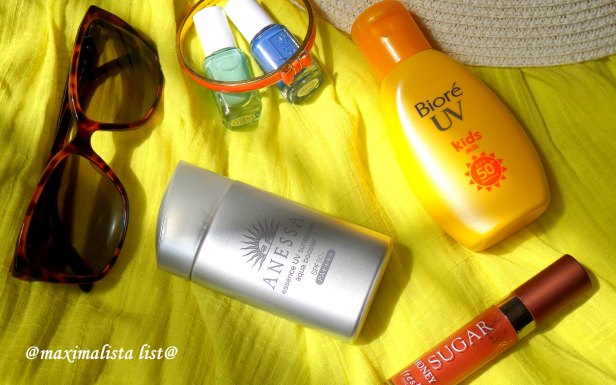
In between different brands of sunscreens I tried for the years Asia, and especially Japanese always worked much better than European which are in their turn far better than American (be honest, today FDA approves 16 sun protecting compounds only and most of them are UVB protectors only!). Just a small example: British researcher Brian Diffey evaluated the UV protection of four U.S. sunscreens and four sold in Europe, each of which had an SPF value of 50 or 50+. He found that the U.S. sunscreens allowed, on average, three times more UVA rays to pass through to skin than European products, which included the modern UVA filters (Diffey 2015).
Japanese market of sun protection is much more ahead of European. Every year new formulas are coming to the stores, and they are much more stronger in way of sun protection, defensive, and in same way lighter by texture and more pleasant to use.
All facts from above made me a huge fan of Japanese sunscreens, and although I’m periodically trying new sun products from European brands, after all I’m back to my Japanese “friends”.
This year I decided to go with recently reformulated (in 2016) Anessa and Biore sunscreens.
Anessa Essence UV Sunscreen Aqua Booster SPF50+ PA++++
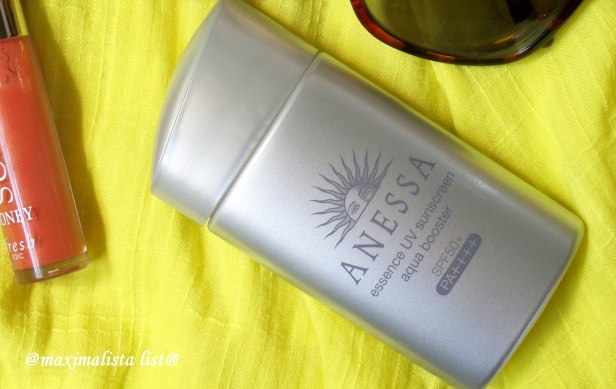
Light moisturizing formula was created for outdoor activities and sport lovers. It contains Hyaluronic acid GL keeping skin hydrated in extreme temperatures. It formulated with patented Aqua Boost technology, which reacts with the minerals in perspiration and water upon contacts to create even more strong and uniform protecting “wrap” or veil that increases UV protection by 20%. Another Shiseido’s patented “Light Stamina” technology helps to release energy from UV light as a heat to ensure more long-lasting stable protection without overheating. This product is resistant to water (80 minutes), sweat and sebum.
The texture is light, very liquid. It is very easy to spread but for first few minutes you’ll notice some shininess and kind of slightly oily or greasy feeling (thanks to silicones) over the skin. But give the product few minutes “to set” and this feeling of greasy residue will disappear. It reminds me some silicone-based primers, and yet Anessa Essence UV Sunscreen Aqua Booster can work perfectly as a primer layer before applying foundation.
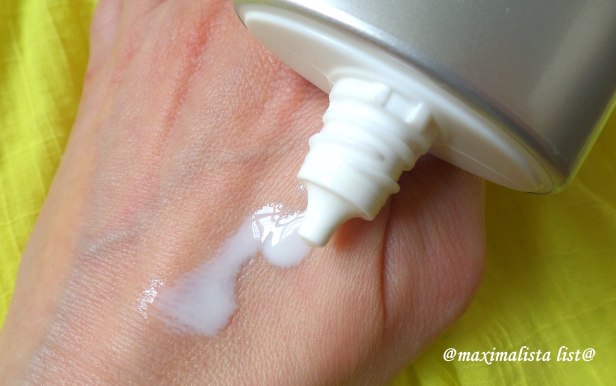
Active UV filters: Octinoxate, Parasol SLX, Zinc Oxide, Octocrylene, Uvinul A Plus and Tinosorb S .
More detailed about each of sun blocker in this formula:
Оctinoxate is the oldest and most common sunscreen active used to protect skin, primarily against UVB rays. Although octinoxate does provide some UVA protection, it does not protect against the entire range of UVA wavelengths.
Octocrylene is globally-approved sunscreen agent that protects skin from the UVB range of sunlight. It also helps stabilize the UVA sunscreen active, avobenzone.
Parasol SLX is a new formulation that combines nanopigments to offer unparalleled protection agains UVB rays.
Uvinul A Plus is an organic compound used in sunscreens to absorb UVA radiation. It has excellent photostability and compatibility with other UV absorbers and other cosmetic ingredients. Uvinul A plus has been approved for the use in sunscreens in the European Union since 2005 and is also approved in South America, Mexico, Japan and Taiwan.
Tinosorb S is a broad-spectrum UV absorber, absorbing UVB as well as UVA rays. It is highly photostable. Even after 50 MEDs (minimal erythemal doses), 98.4% remains intact. It helps prevent the photodegradation of other sunscreen actives like avobenzone. Tinosorb S is the most effective UV absorber available measured by SPF, based on the maximum concentration permitted by European legislation. This UV filter is not approved by the US FDA, but is approved in the European Union since the year 2000 and other parts of the world, including Australia.
Unlike some other organic sunscreen actives, it shows no estrogenic effects in vitro.
Zinc oxide is one of only 17 active ingredients currently approved by the FDA for use in sunscreens. Upon application, zinc oxide particles sit on the outermost layer of your skin, the stratum corneum, where they scatter, absorb, and reflect ultraviolet radiation, protecting your living skin below. Zinc oxide is a physical sunscreen filter and broad-spectrum blocker, protecting from UVA, UVB, and even UVC.
Full list of ingredients (from COSDNA): Dimethicone, Water, Diisopropyl sebacate, Ethylhexyl methoxycinnamate, Alcohol, Isododecane, Polysilicone-15, Polymethyl Methacrylate, VINYL DIMETHICONE/METHICONE SILSESQUIOXANE CROSSPOLYMER, Zinc Oxide, Glycerin, Octocrylene, Lauryl PEG-9 Polydimethylsiloxyethyl Dimethicone, Polymethylsilsesquioxane, Diethylamino Hydroxybenzoyl Hexyl Benzoate, Silica, Bis-ethylhexyloxyphenol methoxyphenyl triazine, Phytosteryl macadamiate, PEG/PPG-14/7 dimethyl ether, Еthyl Ascorbic Acid, Rosa Centifolia Flower Water, Dipotassium Glycyrrhizate, Angelica Acutiloba Root Extract, Thymus Serpillum Extract, Rosa Roxburghii Fruit Extract, Sodium Hyaluronate, Rosa Centifolia Flower Extract, Curcuma Longa Root Extract, PPG-17, Isostearic Acid, Sucrose tetrastearate triacetate, Disteardimonium Hectorite, Dextrin palmitate, Trisodium EDTA, Triethoxycaprylylsilane, Talc, Butylene Glycol, Hydrogen Dimethicone, BHT, Tocopherol, Distearyldimonium chloride, Stearic Acid, Sodium Metabisulfite, Fragrance
Price: around $30 for 60 ml. You can easily find it on Amazon with free shipping.
Biore UV Kids Milk SPF50+ PA++++
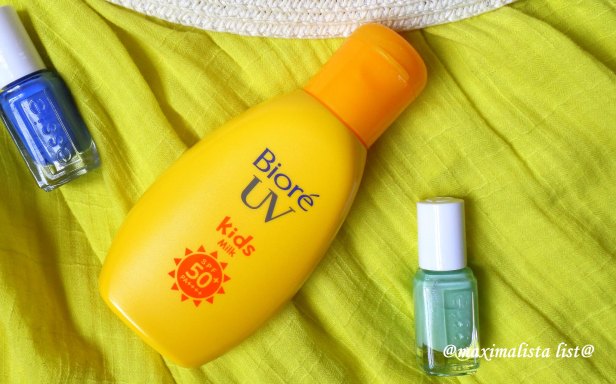
This lightweight and smooth sun protective milk is formulated for kids and people with sensitive skin. It features Kao patented “MocchiriVeil” micro-encapsulated technology allows the product to spread more evenly without penetrating deep into epidermis. Any contacts with water or sweat makes the UV-protection even more long-lasting. The texture is light, silky and non-sticky which makes Biore UV Kids Milk ideal for outdoor activities.
You can see how “milky” is this staff. I can call this texture “soft”, very pleasant to touch and easy to distribute over the skin. It absorbs quickly without any greasiness or shiny finish. Just nice feeling of soft “fresh creamed” skin!
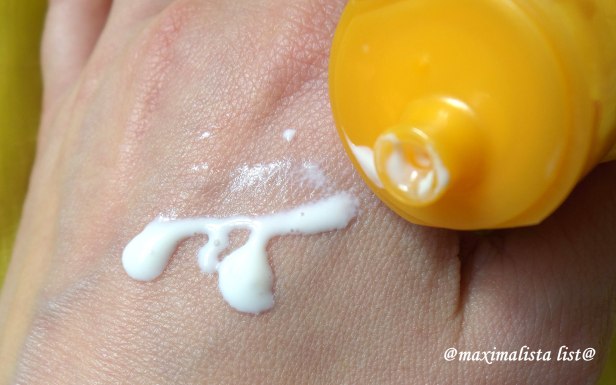
Active UV filters: Octinoxate, Tinosorb S, Uvinul A Plus and Uvinul T150.
Infornation about Octinoxate, Tinosorb S and Uvinul A Plus you can see above under Anessa description.
Uvinul T150 is a highly effective UVB radiation absorber that is a triazine derivative. The polar nature of Uvinul® T 150 gives it good affinity to the keratin in the skin, so that formulations in which it is used are particularly water-resistant. This property is further enhanced by its complete insolubility in water. This UVB filter is not approved for use in OTC sunscreen products in the USA.
Full list of ingredients (from COSDNA): Water, Ethylhexyl methoxycinnamate, C12-15 alkyl benzoate, Glycerin, Propanediol, Cyclopentasiloxane, Bis-ethylhexyloxyphenol methoxyphenyl triazine, Glyceryl behenate, Diethylamino Hydroxybenzoyl Hexyl Benzoate, Dimethicone, Cetyl Alcohol, Sorbitan distearate, Sodium acrylate/acryloyldimethyl taurate copolymer, Sodium stearoyl glutamate, Paraffin, Ethylhexyl Triazone, Ceresin, Isohexadecane, Arginine, Lauryl Methacrylate/Sodium Methacrylate Crosspolymer, Polysorbate 80, PEG-12 Dimethicone, Dextrin palmitate, Agar, Petrolatum, Succinic acid, Sodium Dehydroacetate, Methylparaben, Phenoxyethanol, Disodium EDTA, BHT
Price: around $10 on Sasa.com. But again you can buy it from Amazon or eBay.
I’m very happy with my Japanese sunscreens, and definitely will continue to explore and use them in future. Why? Because I trust these formulas and know for sure that they are reliable and protect me in the best and most optimal way! Modern environment is very far from be good, and wearing reliable sun protection every day becomes absolute necessity. And my belief that most of Japanese sun products (especially so popular and “permanently improved” like Anessa and Biore) are reliable and trustworthy as they can be!
What are yours favorite Japanese or nor Japanese sunscreens?
Stay young and beautiful and keep you skin protecting from UV rays!
With love,
Renata

а симпатичный леопардик ты бы была 🙂
в первом мне структура нравится.
кстати, интерестно, что в детском секторе химическая защита, обычно там на механическом основано.
и паки такие летние!
LikeLike
Да уж! Пятнистые ножки меня особо не вдохновили. А пятнышки ветлиго остались. Японцы особо физической не доверяют, особенно на детях. Она же от всего стирается с кожи, а бати везде трутся. Вот и придумали такую смесь.
LikeLike
спасибо, я почитаю… потому что как раз все детсккие меня нанесением и белизной бесят. но раньше вроде как читала, что детям химию не рекомендуют. поищу информацию, спасибо! как минимум, может мне самой хоть подойдет 🙂
LikeLike
Видимо японским детям подходит! А у них там строго с детским здоровьем. И вообще, до определённого возраста детей вообще лучше на солнце не выводить и уж если вывел, то одевать их в специальные костюмчики. Они самые надёжные и уж точно никакого вреда не нанесут!
LikeLike
хорошие проверенные марки,но я не пробовала)
и на лето еще ничего не приобрела, у нас пока мало солнца,видимо поэтому)
LikeLike
Я с защитой всегда, и зимой и летом, не взирая на количество солнца. Мне кажется, что защита – это самый реально работающий антивозрастной фактор из всех. Поэтому и ношу постоянно. А ты не затягивай с поисками, лето уже на носу!
LikeLike
Рената,а они не беловатые на коже? Какой-то от Биоре у меня,выбеливает лицо :(( Еще у меня вечная проблема с тем,чтобы для жирной кожи подходили.. как думаешь,подойдут мне твои японцы ?
LikeLike
Совершенно без белизны. Ни капельки. Оба легкие. Анесса требует чуть больше времени на усадку, она поначалу оставляет чуть жирноватое ощущение на коже. Но это силиконы, масел там нет. А потом все устаканивается и кожа почти сухая. Бьоре недоргой, можно рискнуть. Максимум, ты его потом на тело вымжехшь. А у Анессы есть маленькие половинные дорожные размеры. Может стоит купить такой?
LikeLike
Спасибо,коенчно стоит купить! Я сейчас пользуюсь купленной по твоей наводке Байодермой,мне нравится она.
LikeLike
Я ее уже прикончила. Мне нужно много защитного, лето предстоит жаркое!
LikeLike
А почему не повторяешь Биодерму? Лето жаркое будет в прямом смысле?Я не слышала.Сейчас дурная погода такая.
LikeLike
Биодерму надо из Европы заказывать, а с японцвми легче, есть на Амазоне. Мне нужна супер защита по причине некоторых перемен летом. Я позже о них расскажу.
LikeLike
понятно 🙂
LikeLike
Я тоже фанат японских санскринов 🙂 Особенно после того, как взяла с собой целую гору европейских санскринов в тропики, и регулярно подгорала, натираясь ими с утра до ночи. Теперь пользуюсь Biore и беды не знаю. Анессу любопытно попробовать, но она стоит в 3 раза дороже Biore, а я совсем не уверена, что она в 3 раза лучше 🙂
LikeLike
Японцы по защите впереди всех! Я хоть и срываюсь на европейские марки периодами, но всегда возвращаюсь к японским маркам с Анессой во главе. Бьоре мне нравится по текстуре, но в “тяжелых” жарких условиях я его пока не испытывала. А вот Анесса не раз проходила подобные испытания и всегда на ура. Состав у Анессы, как видишь более симпатичный, с антиоксидантами и хорошими экстрактами. Бьоре куда химичнее, не такой sophisticated, и даже содержит минеральное масло. И упаковка здесь куда проще и дешевле выглядящая. Однако от защиты сильного ухода не ожидаешь, поэтому, в принципе, можно и не переплачивать.
LikeLike